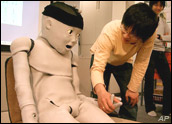
Researchers at Osaka University in Japan demonstrated on Friday a toddler robot designed to assist in studies of child development.
Called the “Child-Robot with Biomimetic Body,” or CB2, the robot is designed to mimic a real, human child between one and three years old. It stands just over 4 feet tall, weighs 73 pounds, and crawls, changes its facial expressions, and can make sounds using an artificial vocal cord, according to the Associated Press.
Fifty-six actuators control its motion and 197 sensors simulate touch, while cameras and an audio sensor give it vision and hearing, the AP said.
Research Tool
Robotic devices are commonly used in studying child development, Dan Kara, president of Robotics Trends, told TechNewsWorld.
In some cases they are programmed to undertake some action, while researchers study the reactions of real children watching; in others, the robot may be put in some situation, and the real children are asked what they think the robot should do, Kara explained.
A ‘Creepy’ Success?
Perhaps more interesting about this particular robot, however, are the reactions with which it has been viewed since its demonstration. “Some people called it creepy,” Dale Musser, robotics industry watcher and owner of Eyebits Studios, told TechNewsWorld.
Indeed, while the machine is very lifelike, many have found it disturbing at the same time. “There’s a lot of work to be done in terms of creating natural-looking motion in robots, and the fact that some people found this one creepy may mean the researchers were in fact successful,” Musser noted.
“How many times have you looked at a machine and found it creepy? We usually apply that term to strange human behavior,” he added. “The fact a human had a response like that makes it interesting.”
The Uncanny Valley
In fact, robotics researchers have a term for what causes that kind of reaction: the “uncanny valley.”
“What this robot represents, and why a lot of people get creeped out by it, is the uncanny valley, which is a term we use to describe robots or other animatronic devices that look really realistic but are off just a little bit,” Kara explained. “They’re not quite there, and it’s much more disturbing than if they simply looked machinelike.”
It is because of the uncanny valley that creators of robotic toys and other consumer-oriented robot devices usually don’t try to make them look completely realistic, Kara said.
The Cuddly ‘Paro’
A baby harp seal robot known as the “Paro,” for instance, is used in Japan in assisted living homes in place of real, live pets as a form of animal-assisted therapy. “The reason they chose a seal is that people are too familiar with cats and dogs — they know exactly how they should look,” Kara explained. “People know seals, but they don’t usually know exactly how a seal looks.”
The Paro’s fur is longer than a real seal’s, and its face is more babylike — not just to enhance its cuteness, but also because its developers “didn’t want to fall into the uncanny valley,” Kara said.
For the CB2, it remains to be seen what kind of effect the device’s uncanniness will have on its usefulness as a research tool.





















































